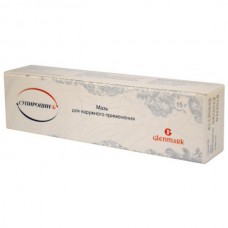Expiration date: 06/2025
Clinico-pharmacological group
(Antibiotic for external use)
Release form, composition and packaging
Ointment for topical application 1g contains:
mupirocin 20 mg
betamethasone (dipropionate) 500 mcg
5 g - tubes aluminum (1) - packs of cardboard.
Pharmacological action
Combined preparation for external use, which is due to its constituent components.Mupirocin is an antibiotic produced by the microorganism Pseudomonas fluorescens. Mupirocin inhibits protein synthesis of bacterial cells by reversibly binding to isoleucyl-transfer RNA-synthetases that prevents the incorporation of isoleucine into newly built protein chain. When used in a minimum of ingibiruyah concentrations of mupirocin has bacteriostatic, but in higher concentrations - bactericidal action.Due to its specific mechanism of action and unique chemical structure, cross-resistance with other antibiotics is missing. With proper application of mupirocin to the risk of emergence of resistant strains of microorganisms is small.Betamethasone is a glucocorticosteroid for external use.Anti-inflammatory local, anti-allergic, anti-edematous and anti-proliferative action. Has a stronger vasoconstrictor action than other forprostate corticosteroids, systemic effects are negligible due to the limited absorption through the skin. When exposed to the skin is a warning to the boundary accumulation of neutrophils, which leads to the decrease of exudation, production of cytokines, inhibition of migration of macrophages, leading ultimately to the reduction processes of infiltration and granulation.
Pharmacokinetics
Mupirocin practically does not penetrate intact skin. In the case of adsorption through intact skin is metabolized to microbiologically inactive metabolite - monievu acid and rapidly excreted by the kidneys.Betamethasone dipropionate is a lipophilic substance and is readily absorbed through the stratum corneum of the skin without undergoing biotransformation. Absorption is increased when applied to the skin in the folds of the body, skin damaged epidermis or to the area of inflammation, frequent use of the drug or after application to a considerable surface of the skin. The absorption of betamethasone dipropionate through the skin in children is faster than adults.
Dosage
Recommended dosage: apply the ointment in a thin layer to affected area 2-3 times daily for 5-14 days. To apply only for treatment of the affected places having a length of not more than 10 cm or an area not exceeding 100 cm2. If in 3-5 days in patients not observed clinical responses, they need to be checked.
Overdose
Symptoms: reversible depression of the hypothalamic-pituitary-adrenal axis, manifestations of Cushing's syndrome, hyperglycemia, glucosuria.Treatment: symptomatic.Medicinal vzaimodeistviyami of the drug with other drugs have not been identified.
Pregnancy and lactation
The drug is contraindicated during pregnancy and lactation.
Side effects
Burning, itching, irritation, dryness, folliculitis, hypertrichosis, pustular rash, hypopigmentation, okolorotova dermatitis, allergic contact dermatitis, maceration of skin, secondary infection, skin atrophy, miliaria.
Terms and conditions storage
At temperatures above 25°C. do Not freeze. Keep out of reach of children. Shelf life - 2 years.
Testimony
— the treatment of atopic dermatitis, diffuse neurodermatitis, contact dermatitis (simple and allergic), exfoliative dermatitis, hives, dermatitis herpetiformis, seborrheic dermatitis, eczema, psoriasis, complicated by secondary bacterial infections.
Contraindications
— skin manifestations of syphilis, tuberculosis skin, bacterial, viral, fungal skin diseases, trophic ulcers of the lower leg, associated with varicose veins— skin cancer, nevus, sebaceous cyst, melanoma, hemangioma, xanthoma, Kaposi,— rosacea— acne vulgaris— the post-vaccination skin reactions— pregnancy and breastfeeding— children under 12 years hypersensitivity.
With caution
Macrogol (polyethylene glycol) may be absorbed through the wound surface or other damage to the skin and excreted by the kidneys.Ointment on the basis macrogol cannot be used on large surfaces for conditions accompanied by increased absorption of polyethylene glycol, especially for moderate and severe renal failure.For patients with diabetes, glaucoma, tuberculosis, cataract is not recommended for long-term use of ointment on large areas of skin.Caution should be used when atrophy of the subcutaneous tissue, especially in the elderly.
Special instructions
Avoid contact ointments in the eye, mucous membranes and open wounds and burns. As with other antibacterial substances, prolonged use of ointments can lead to excessive growth of insensitive to its action of organisms, including fungi.Given the presence of a potent glucocorticosteroid drug, the drug should be administered in the acute period of the disease, short-term, minor skin surface.You should not use the drug on the skin of the person in connection with the possibility of the appearance of telangiectasia, perioral dermatitis. On the skin in axillary and inguinal region drug should be used only in cases of extreme necessity.You should not use the drug under occlusive dressing, because this can lead to atrophy of the epidermis, the appearance of stretch marks, development of superinfection.Used in the dysfunction of packmate based on macrogol cannot be used on large surfaces for conditions accompanied by increased absorption of polyethylene glycol, especially for moderate and severe renal failure.
Supirocin-B
(Mupirocin
+
Betamethasone)
2%
15g
ointment
- Brand: Glenmark

- Availability:
in stock
Categories:
-
$20.00

